
Hobelars were a type of light cavalry, or mounted infantry, used in Western Europe during the Middle Ages for skirmishing. They originated in 13th century Ireland, and generally rode hobbies, a type of light and agile horse.

Hobelars were a type of light cavalry, or mounted infantry, used in Western Europe during the Middle Ages for skirmishing. They originated in 13th century Ireland, and generally rode hobbies, a type of light and agile horse.
According to James Lydon, "There can be little doubt that the hobelar as a type of soldier originated in Ireland ... between the fully armoured knight on the 'equus coopertus' and the lightly armoured archer on the 'equus discoopertus' there was an intermediate stage. This intermediary ... was provided by the hobelar." He further states that hobelars
were highly mobile, and excelled in scouting, reconnaissance and patrols ... eminently suited to the terrain in which military operations had to be conducted in Ireland. However superior the Norman knight might be upon the field of battle, the bogs and woods of Ireland gave little opportunity for the mail-clad charge. Thus there evolved in Ireland, as a habitual part of every Anglo-Norman force, a type of light horseman, which came to known as the hobelar. It was only a matter of time until this phenomenon found its way ... into other Anglo-Norman armies across the Irish Sea. [1]
More recently, however, this view has been challenged by Robert Jones, who believes that the ancestor of the hobelar was a form of second class cavalryman called a muntator. These soldiers originated in the Anglo-Welsh armies which invaded Ireland in the 12th century. Jones accepts, however, that the hobelar diverged from the Anglo-Welsh muntator during the 13th century, with the hobelar becoming lighter armed, perhaps for economic reasons. The hobelar is thus still seen as a response to military conditions in Ireland, rather than elsewhere. [2]
Hobelars were used successfully by both sides during the Wars of Scottish Independence, with Edward I of England trying to gain advantage by preventing Irish exports of hobbies to Scotland. Robert Bruce employed the hobby for his guerilla warfare and mounted raids, covering 60 to 70 miles (100 to 110 km) a day. [3] Within Ireland and Britain (and beyond), they were well-known and highly valued. Edward I was much impressed by the abilities of the Irish hobelar, resulting in extensive use of them in Scotland, even procuring six of them from the Decies for his own personal use.
The first reference to hobelars dates to 1296 in Ireland, when 260 accompanied a contingent of Irish troops to Scotland under John Wogan, as part of Edward I's army. Not until after 1300 were there any references of English hobelars. Edward mustered fourteen at Carlisle in June 1301. The following year he had three hundred and ninety included in an Irish force of two thousand three hundred. This rose to a total of four hundred and ninety-nine (out of an army of three thousand, four hundred) in 1303, all indicative of their value as light cavalry. [4]
It is clear from their rapid adoption into English armies operating in Scotland that the hobelar met a perceived tactical need and, in the early years of the 14th century, hobelars were to be found in all the major border garrisons. [5] It is also clear that these hobelars are increasingly Englishmen, rather than Irish. Of the 845 hobelars at the siege of Berwick in 1319, 500 were from Cumberland and Westmorland, 36 from Barnard Castle, 24 from Norham and 45 from Tynedale. [6] 376 English, 10 Welsh and 139 Irish hobelars were mustered at Newcastle in 1322. [7] The hobelar became a standard feature in English forces throughout the country in the 1320s and 1330s. Muster records for 1326 show hobelars being recruited in Norfolk, Suffolk and Oxfordshire. [8]
In the 1330s, however, a new type of mounted infantryman begins to be recorded; the mounted archer. [9] In the period 1335 to 1350, the mounted archer gradually surpassed the hobelar as the predominant mounted auxiliary, especially for foreign service. For example, of the troops summoned to serve at the siege of Calais in 1346–47, 600 were hobelars as against 5000 mounted archers. [10] At the same time, however, the hobelar's place within the structure of English military obligation crystallised. The arms of a hobelar were first formally defined in 1335. [11] In 1346, it was defined that a man with £10 of goods was to be armed as a hobelar [12]
The hobelar remained a named constituent of local forces through the rest of the 14th century but was less commonly mentioned in the 15th century. [13] The final reference to hobelars appears to be a commission of array in Norfolk and Suffolk in 1485. [14]
There is no surviving description of the equipment of the original Irish hobelar, but they may have been equipped after the style of native Irish cavalry of the period, who wore aketons, hauberks, and basinets and wielded swords, scians [15] and lances. The pony itself was unarmoured, and was ridden in the Irish style, i.e., no saddle, no bridle, no stirrups. In the 1335 description mentioned above, the English hobelar equipment is listed as horse, aketon or plates, basinet or palet, gorget, iron gauntlets, sword, knife, and lance. [16]
The native Irish horse, the Irish hobby, represented today by the Connemara pony,[ citation needed ] was a horse measuring twelve to fourteen hands high. Their name derives from the word 'hobin', a French word thought to be derived from the Gaelic term 'obann', meaning 'swift.' Though small, the hobby was not necessarily a horse of poor quality. The average value of 11 hobbies used in 1336 in Scotland was £6.8, slightly less than the average for other warhorses, but two hobbies were valued at £10. Another lost during the 1338 campaign in Flanders was valued at 20 marks (£13.6s.8d.) [17]

The Battle of Crécy took place on 26 August 1346 in northern France between a French army commanded by King Philip VI and an English army led by King Edward III. The French attacked the English while they were traversing northern France during the Hundred Years' War, resulting in an English victory and heavy loss of life among the French.

A fyrd was a type of early Anglo-Saxon army that was mobilised from freemen or paid men to defend their Shire's lords estate, or from selected representatives to join a royal expedition. Service in the fyrd was usually of short duration and participants were expected to provide their own arms and provisions.

A man-at-arms was a soldier of the High Medieval to Renaissance periods who was typically well-versed in the use of arms and served as a fully-armoured heavy cavalryman. A man-at-arms could be a knight, or other nobleman, a member of a knight's or nobleman's retinue, or a mercenary in a company serving under a captain. Such men could serve for pay or through a feudal obligation. The terms knight and man-at-arms are often used interchangeably, but while all knights equipped for war were men-at-arms, not all men-at-arms were knights.
The lance fournie was a medieval equivalent to the modern army squad that would have accompanied and supported a man-at-arms in battle. These units formed companies under a captain either as mercenary bands or in the retinue of wealthy nobles and royalty. Each lance was supposed to include a mixture of troop types that would have guaranteed a desirable balance between the various components of the company at large; however, it is often difficult to determine the exact composition of the lance in any given company as the available sources are few and often centuries apart.

Light cavalry comprised lightly armed and armored cavalry troops mounted on fast horses, as opposed to heavy cavalry, where the mounted riders were heavily armored. The purpose of light cavalry was primarily raiding, reconnaissance, screening, skirmishing, patrolling, and tactical communications. Prior to the 17th century they were usually armed with swords, spears, javelins, or bows, and later on with sabres, pistols, shotguns, or carbines.

The destrier is the best-known war horse of the Middle Ages. It carried knights in battles, tournaments, and jousts. It was described by contemporary sources as the Great Horse, due to its significance.
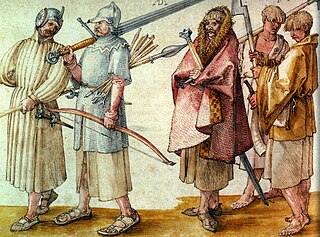
Gaelic warfare was the type of warfare practiced by the Gaelic peoples, in the pre-modern period.

Historically, Scotland has a long military tradition that predates the Act of Union with England. Its soldiers form part of the armed forces of the United Kingdom, more usually referred to domestically within Britain as the British Armed Forces.

The first evidence of horses in warfare dates from Eurasia between 4000 and 3000 BC. A Sumerian illustration of warfare from 2500 BC depicts some type of equine pulling wagons. By 1600 BC, improved harness and chariot designs made chariot warfare common throughout the Ancient Near East, and the earliest written training manual for war horses was a guide for training chariot horses written about 1350 BC. As formal cavalry tactics replaced the chariot, so did new training methods, and by 360 BC, the Greek cavalry officer Xenophon had written an extensive treatise on horsemanship. The effectiveness of horses in battle was also revolutionized by improvements in technology, such as the invention of the saddle, the stirrup, and the horse collar.
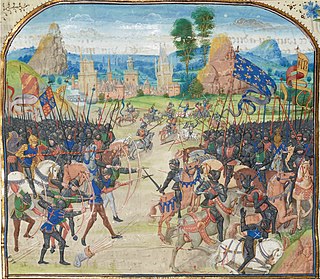
The term rouncey was used during the Middle Ages to refer to an ordinary, all-purpose horse. They were used for riding, but could also be trained for war. It was not unknown for them to be used as pack horses. The horse, which was also referred to as runcinus, is believed to be a harrowing animal on account of its proportions found in the demesne stock listing before it became an exclusively riding animal.
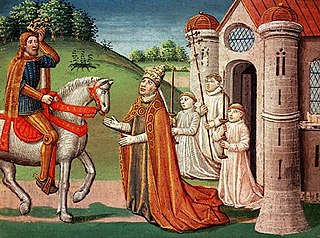
Horses in the Middle Ages differed in size, build and breed from the modern horse, and were, on average, smaller. They were also more central to society than their modern counterparts, being essential for war, agriculture, and transport.

Henry de Loundres was an Anglo-Norman churchman who was Archbishop of Dublin, from 1213 to 1228. He was an influential figure in the reign of John of England, an administrator and loyalist to the king, and is mentioned in the text of Magna Carta, the terms of which he helped to negotiate.
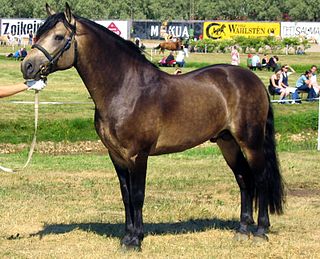
The Irish Hobby is an extinct breed of horse developed in Ireland prior to the 13th century. The breed provided foundation bloodlines for several modern horse breeds, including breeds as diverse as the Connemara pony and the Irish Draught. Palfreys were known as haubini in France, which eventually became hobbeye. These animals eventually found their way to Ireland where the Irish Hobby developed.
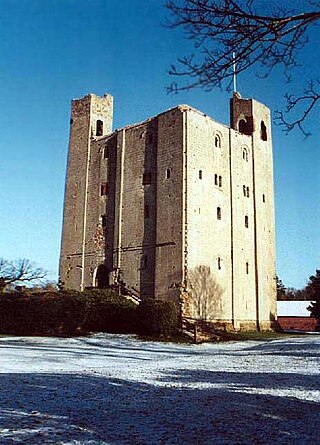
John de Vere, 7th Earl of Oxford was the nephew and heir of Robert de Vere, 6th Earl of Oxford who succeeded as Earl of Oxford in 1331, after his uncle died without issue.
James Francis Lydon was an Irish educator and historian. He served as the Lecky Professor of History at Trinity College, Dublin, from 1980 to 1993, and authored numerous works, particularly on the medieval history of Ireland.
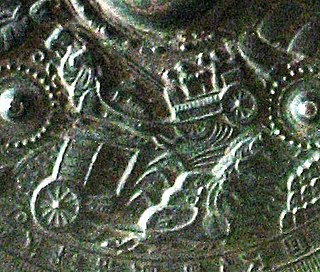
Horses in East Asian warfare are inextricably linked with the strategic and tactical evolution of armed conflict throughout the course of East Asian military history. A warrior on horseback or horse-drawn chariot changed the balance of power between the warring civilizations throughout the arc of East Asian military history.

The known history of the horse in Britain starts with horse remains found in Pakefield, Suffolk, dating from 700,000 BC, and in Boxgrove, West Sussex, dating from 500,000 BC. Early humans were active hunters of horses, and finds from the Ice Age have been recovered from many sites. At that time, land which now forms the British Isles was part of a peninsula attached to continental Europe by a low-lying area now known as "Doggerland", and land animals could migrate freely between what is now island Britain and continental Europe. The domestication of horses, and their use to pull vehicles, had begun in Britain by 2500 BC; by the time of the Roman conquest of Britain, British tribes could assemble armies which included thousands of chariots.

A hobby horse is a child's toy horse. Children played at riding a wooden hobby horse made of a straight stick with a small horse's head, and perhaps reins, attached to one end. The bottom end of the stick sometimes had a small wheel or wheels attached. This toy was also sometimes known as a cock horse or stick horse.
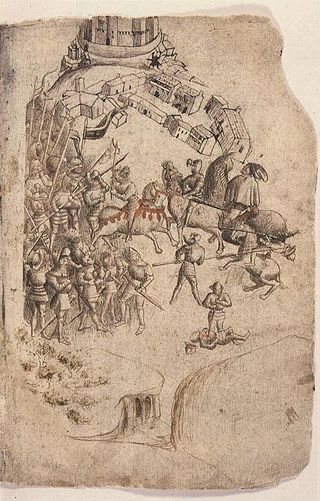
Warfare in Medieval Scotland includes all military activity in the modern borders of Scotland, or by forces originating in the region, between the departure of the Romans in the fifth century and the adoption of the innovations of the Renaissance in the early sixteenth century. In this period conflict developed from minor raids to major conflicts, incorporating many of the innovations of continental warfare.